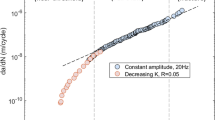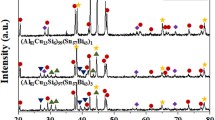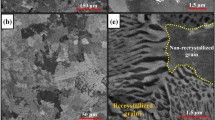Abstract
Materials synthesis via additive manufacturing gives unprecedented control over the solidified microstructure. While a number of studies have demonstrated the ability to produce spatially varying microstructures, little work exists to understand the behavior of such “composite” materials. In this work, we utilized electron beam melting to process Ni-based superalloy Haynes 282 and produce compact tension samples with a spatially varying mesoscale structure. Fatigue crack growth experiments reveal that the crack growth rate is dependent on the degree of microstructural heterogeneity. This work demonstrates that the crack growth resistance can be tailored within a component using electron beam melting additive manufacturing.
















Similar content being viewed by others
References
Adair D, Kirka M, Ryan D (2019) Additive manufacture of prototype turbine blades for hot-fired engine performance validation trials. In: Turbo Expo: Power for Land, Sea, and Air, vol. 58677 (American Society of Mechanical Engineers, 2019), vol. 58677, p V006T24A012
Kirka MM, Fernandez-Zelaia P, Lee Y, Nandwana P, Yoder S, Acevedo O, Ryan D (2020) Mechanical Performance of a Non-weldable Ni-Base Superalloy: Inconel 738 Fabricated by Electron Beam Melting. Superalloys 2020, Springer, pp 1075–1084
Fernandez-Zelaia P, Ledford C, Ellis EA, Campbell Q, Rossy AM, Leonard DN, Kirka MM (2021) Crystallographic texture evolution in electron beam melting additive manufacturing of pure molybdenum. Mater Des 207:109809
Lee Y, Kirka MM, Ferguson J, Paquit VC (2020) Correlations of cracking with scan strategy and build geometry in electron beam powder bed additive manufacturing. Addit Manuf 32:101031
Lee Y, Kirka MM, Kim S, Sridharan N, Okello A, Dehoff RR, Babu SS (2018) Asymmetric cracking in mar-m247 alloy builds during electron beam powder bed fusion additive manufacturing. Metall Mater Trans A 49(10):5065–5079
Sames WJ, List F, Pannala S, Dehoff RR, Babu SS (2016) The metallurgy and processing science of metal additive manufacturing. Int Mater Rev 61(5):315–360
Müller Av, Schlick G, Neu R, Anstätt C, Klimkait T, Lee J, Pascher B, Schmitt M, Seidel C (2019) Additive manufacturing of pure tungsten by means of selective laser beam melting with substrate preheating temperatures up to 1000c. Nucl Mater Energy, 19:184–188
Uddin SZ, Espalin D, Mireles J, Morton P, Terrazas C, Collins S, Murr LE, Wicker R (2017) Laser powder bed fusion fabrication and characterization of crack-free aluminum alloy 6061 using in-process powder bed induction heating. In: Proceedings of SFF symposium (2017), vol. 2017, pp 214–227
Raghavan N, Dehoff R, Pannala S, Simunovic S, Kirka M, Turner J, Carlson N, Babu SS (2016) Numerical modeling of heat-transfer and the influence of process parameters on tailoring the grain morphology of IN718 in electron beam additive manufacturing. Acta Mater 112:303–314
Raghavan N, Simunovic S, Dehoff R, Plotkowski A, Turner J, Kirka M, Babu S (2017) Localized melt-scan strategy for site specific control of grain size and primary dendrite arm spacing in electron beam additive manufacturing. Acta Mater 140:375–387
Dehoff RR, Kirka M, Sames W, Bilheux H, Tremsin A, Lowe L, Babu S (2015) Site specific control of crystallographic grain orientation through electron beam additive manufacturing. Mater Sci Technol 31(8):931–938
Fernandez-Zelaia P, Kirka MM, Dryepondt SN, Gussev MN (2020) Crystallographic texture control in electron beam additive manufacturing via conductive manipulation. Mater Design 195:109010
Wei H, Mazumder J, DebRoy T (2015) Evolution of solidification texture during additive manufacturing. Sci Rep 5:16446
Körner C, Ramsperger M, Meid C, Bürger D, Wollgramm P, Bartsch M, Eggeler G (2018) Microstructure and mechanical properties of CMSX-4 single crystals prepared by additive manufacturing. Metall Mater Trans A 49(9):3781–3792
Ramsperger M, Singer RF, Körner C (2016) Microstructure of the nickel-base superalloy CMSX-4 fabricated by selective electron beam melting. Metall and Mater Trans A 47(3):1469–1480
Chauvet E, Tassin C, Blandin JJ, Dendievel R, Martin G (2018) Producing Ni-base superalloys single crystal by selective electron beam melting. Scripta Mater 152:15–19
Popovich V, Borisov E, Sufiyarov VS, Popovich A (2019) Tailoring the properties in functionally graded alloy inconel 718 using additive technologies. Metal Sci Heat Treat 60(11–12):701–709
Thijs L, Sistiaga MLM, Wauthle R, Xie Q, Kruth JP, Van Humbeeck J (2013) Strong morphological and crystallographic texture and resulting yield strength anisotropy in selective laser melted tantalum. Acta Mater 61(12):4657–4668
Kunze K, Etter T, Grässlin J, Shklover V (2015) Texture, anisotropy in microstructure and mechanical properties of IN738LC alloy processed by selective laser melting (SLM). Mater Sci Eng, A 620:213–222
Etter T, Kunze K, Geiger F, Meidani H (2015) Reduction in mechanical anisotropy through high temperature heat treatment of Hastelloy X processed by Selective Laser Melting (SLM). In: IOP conference series: materials science and engineering, (IOP Publishing, 2015), vol. 82, p 012097
Montero-Sistiaga ML, Pourbabak S, Van Humbeeck J, Schryvers D, Vanmeensel K (2019) Microstructure and mechanical properties of Hastelloy X produced by HP-SLM (high power selective laser melting). Mater Design 165:107598
Balachandramurthi AR, Moverare J, Dixit N, Deng D, Pederson R (2019) Microstructural influence on fatigue crack propagation during high cycle fatigue testing of additively manufactured Alloy 718. Mater Charact 149:82–94
Zhai Y, Galarraga H, Lados DA (2016) Microstructure, static properties, and fatigue crack growth mechanisms in Ti-6Al-4V fabricated by additive manufacturing: LENS and EBM. Eng Fail Anal 69:3–14
Zhang X, Martina F, Ding J, Wang X, Williams SW (2017) Fracture toughness and fatigue crack growth rate properties in wire+ arc additive manufactured Ti-6Al-4V. Fatigue Fract Eng Mater Struct 40(5):790–803
Xie Y, Gao M, Wang F, Zhang C, Hao K, Wang H, Zeng X (2018) Anisotropy of fatigue crack growth in wire arc additive manufactured Ti-6Al-4V. Mater Sci Eng, A 709:265–269
Zhang J, Wang X, Paddea S, Zhang X (2016) Fatigue crack propagation behaviour in wire+ arc additive manufactured Ti-6Al-4V: Effects of microstructure and residual stress. Mater Design 90:551–561
Pei C, Shi D, Yuan H, Li H (2019) Assessment of mechanical properties and fatigue performance of a selective laser melted nickel-base superalloy Inconel 718. Mater Sci Eng, A 759:278–287
Nezhadfar P, Burford E, Anderson-Wedge K, Zhang B, Shao S, Daniewicz S, Shamsaei N (2019) Fatigue crack growth behavior of additively manufactured 17-4 PH stainless steel: Effects of build orientation and microstructure. Int J Fatigue 123:168–179
Riemer A, Leuders S, Thöne M, Richard H, Tröster T, Niendorf T (2014) On the fatigue crack growth behavior in 316L stainless steel manufactured by selective laser melting. Eng Fract Mech 120:15–25
Krueger DD, Antolovich SD, Van Stone RH (1987) Effects of grain size and precipitate size on the fatigue crack growth behavior of alloy 718 at 427 C. Metall Trans A 18(8):1431–1449
Higaki M, Sakaguchi M, Matsunami M, Kaneko H, Karato T, Suzuki K, Inoue H (2018) Influence of crystal orientastions and grain boundary on crack propagation behavior at room temperature in a polycrystalline Ni-base superalloy. Trans JSME. https://doi.org/10.1299/TRANSJSME.17-00578 (in Japanese)
Musinski WD, McDowell DL (2016) Simulating the effect of grain boundaries on microstructurally small fatigue crack growth from a focused ion beam notch through a three-dimensional array of grains. Acta Mater 112:20–39
Musinski WD, McDowell DL (2012) Microstructure-sensitive probabilistic modeling of HCF crack initiation and early crack growth in Ni-base superalloy IN100 notched components. Int J Fatigue 37:41–53
Babu SS, Raghavan N, Raplee J, Foster SJ, Frederick C, Haines M, Dinwiddie R, Kirka M, Plotkowski A, Lee Y et al (2018) Additive manufacturing of nickel superalloys: opportunities for innovation and challenges related to qualification. Metall Mater Trans A 49(9):3764–3780
Reed RC (2008) The superalloys: fundamentals and applications. Cambridge University Press, Cambridge
Peterson LG, Foster AD (1991) Turbine blade and production thereof, https://patents.google.com/patent/EP0484025A1/en. EP0484025A1
Haynes 282 brochure. http://haynesintl.com/docs/default-source/pdfs/new-alloy-brochures/high-temperature-alloys/brochures/282-brochure.pdf
Lee Y, Kirka MM, Raghavan N, Dehoff RR (2017) Simulation of spot melting scan strategy to predict columnar to equiaxed transition in metal additive manufacturing. Tech. rep. Oak Ridge National Lab. (ORNL), Oak Ridge, TN United States. 1005–1017
Kirka M, Unocic K, Raghavan N, Medina F, Dehoff R, Babu S (2016) Microstructure development in electron beam-melted Inconel 718 and associated tensile properties. JOM 68(3):1012–1020
Kirka MM, Medina F, Dehoff R, Okello A (2017) Mechanical behavior of post-processed Inconel 718 manufactured through the electron beam melting process. Mater Sci Eng, A 680:338–346
Purgert R, Shingledecker J, Saha D, Thangirala M, Booras G, Powers J, Riley C, Hendrix H (2015) Materials for advanced ultrasupercritical steam turbines. https://www.osti.gov/servlets/purl/1243058
Standard A (2015) E647, Standard test method for measurement of fatigue crack growth rates. Annu Book ASTM Stand, Sect Three: Metals Test Methods Anal Proced 15:1–49
Rans C, Michielssen J, Walker M, Wang W et al (2018) Beyond the orthogonal: on the influence of build orientation on fatigue crack growth in SLM Ti-6Al-4V. Int J Fatigue 116:344–354
Dowling NE (2012) Mechanical behavior of materials: engineering methods for deformation, fracture, and fatigue. Pearson, UK
Gussev MN, Howard RH, Terrani KA, Field KG (2017) Sub-size tensile specimen design for in-reactor irradiation and post-irradiation testing. Nucl Eng Des 320:298–308
Scarlin R (1976) Fatigue crack propagation in a directionally-solidified nickel-base alloy. Metall Trans A 7(10):1535–1541
Acknowledgements
This research was sponsored by the US Department of Energy, Office of Energy Efficiency and Renewable Energy (EERE), Advanced Manufacturing Office under contract DE-AC05-00OR22725 with UT-Battelle LLC and performed in partiality at the Oak Ridge National Laboratory’s Manufacturing Demonstration Facility, an Office of Energy Efficiency and Renewable Energy user facility.
Author information
Authors and Affiliations
Corresponding author
Ethics declarations
Conflict of interest
The authors have no conflicts of interest to declare.
Additional information
Handling Editor: M. Grant Norton.
Publisher's Note
Springer Nature remains neutral with regard to jurisdictional claims in published maps and institutional affiliations.
Notice of Copyright. This manuscript has been authored by UT-Battelle, LLC under Contract No. DE-AC05-00OR22725 with the U.S. Department of Energy. The United States Government retains and the publisher, by accepting the article for publication, acknowledges that the United States Government retains a non-exclusive, paid-up, irrevocable, world-wide license to publish or reproduce the published form of this manuscript, or allow others to do so, for United States Government purposes. The Department of Energy will provide public access to these results of federally sponsored research in accordance with the DOE Public Access Plan (http://energy.gov/downloads/doe-public-access-plan)
Rights and permissions
About this article
Cite this article
Fernandez-Zelaia, P., Rojas, J.O., Ferguson, J. et al. Fatigue crack growth resistance of a mesoscale composite microstructure Haynes 282 fabricated via electron beam melting additive manufacturing. J Mater Sci 57, 9866–9884 (2022). https://doi.org/10.1007/s10853-021-06838-6
Received:
Accepted:
Published:
Issue Date:
DOI: https://doi.org/10.1007/s10853-021-06838-6




